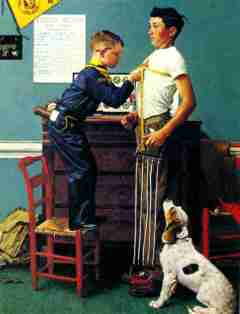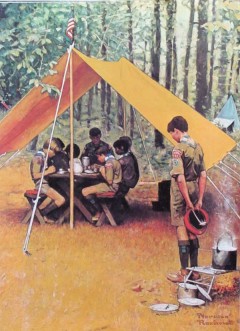 These Questions & Answers are based on opinions by Ken Parham, from troop 400 in Durham who has attended Philmont 4 times since 2007. Ken led this discussion for Troop 505 and here are the questions we asked and his answers listed.
These Questions & Answers are based on opinions by Ken Parham, from troop 400 in Durham who has attended Philmont 4 times since 2007. Ken led this discussion for Troop 505 and here are the questions we asked and his answers listed.
What is cell coverage like at Philmont?
Cell coverage is spotty but available depending on how high an elevation you are at when searching for a signal. Some scouts have brought iphones for video and photos and brought a solar charger to keep there electronics charged up. Philmont discourages too much electronics because they want scouts to enjoy the great outdoors.
Should we wear our scout uniform?
Class A uniforms for Airline travel and during the first and last day in Philmont Base camp. Other than that, the scouts wore whatever they wanted on the trail.
How did you bring your backpack on the airline?
Best way to carry your backpack is to put it in a large duffel bag. If it won’t fit in the duffel with all your stuff in it, you should put it in the duffel empty and load your other stuff around it. This will help prevent damage occurring to your backpack while on the conveyor belts at the airlines, etc.
Did your guys go to Philmont early to get acclimated to the altitude?
They arrived one day early and stayed in base camp at Philmont (you are allowed to stay one night at base camp prior to starting your trek) They do have canvas tents with bunks in them BUT they are on a FCFS basis and if they aren’t available you would have to sleep in your own tents in a designated area at base camp.
How difficult is the acclimation to elevation change?
The first day you are in base camp at 6,000 feet. The next day on the trail you hike about 1.5-3.0 miles with not much elevation change. Philmont tries to do a good job of helping you slowly acclimate.
Did anyone get sick from AMS (Acute Mountain Sickness) or other elevation related issues?
Not sure. One scout had nausea for several days but eventually it went away. A doctor at Philmont reported that the single most reported health issue at Philmont is Nausea. Nausea is one of the symptons of AMS and altitude illness.
Did anyone have any injuries during your trips?
One scout had a sprained ankle. Some adults were sick, etc. Philmont has a very good health facility and if you get sick or injured on the trail the philmont staff will take you off the trail and put you up at the infirmary until you are well enough to return to the trail and then they will take you back to rejoin your Crew.
What did you guys do to physically prepare for Philmont?
We went on several pre-trek backpacking trips. (Uwharrie, AT, etc) The single most reported regret of scouts that attended Philmont was that they didn’t do enough pre-trek hikes. This not only prepares your scouts physically but it also helps you to determine who works well together, what gear you don’t really need, how to pack your backpack for best comfort, makes you more efficient to setup and breakdown your gear, etc. We also tried to encourage scouts to get out and walk in there neighborhoods, at school and during free time with their pack on there backs loaded up with weight. Because even though you may be in great shape you can’t predict how the pack will wear on our body until you do it. The last thing you want to do is be at philmont with a pack you haven’t worn much and it hurts your back.
How did you set up pre-trek hikes?
We set it up into crews just like we would at Philmont with a crew leader, etc and went on backpacking and hiking trips.
What was the average size/ weight of packs carried?
It shouldn’t be more than 1/3 your weight and it should be comfortable. In years past adults have carried 55 lbs +, but older adults are trying to pack lighter. Typical pack weights were 35-45 pounds. Philmont recommends a 4500 cubic inch pack. I mentioned I had purchased an Osprey Atmos 65, and he commented that this pack was borderline and almost too small.
Did anyone drop out of going after they signed up?
Yes, after the first pre-trek hike, a few adults dropped out. Also one scout was injured with a broken leg and couldn’t make the trip.
What about gear, does everyone need to bring a stove or water filter?
We only brought 2 stoves, one to use as a primary and one as a backup. Also Philmont issues each person water purification tablets made from Chlorine Dioxide. (Micropur), water filters are not really necessary but they did bring a c ouple of them.
What about getting water?
Most of the water comes from wells. Typically you will fill up your bottles from a faucet although it still needs to be treated it will look relatively clear. Which you can use the tablets to clean or your water filter if you choose to bring one.
What about the weather and temperature?
Ken brought two pairs of shorts, one pair of long pants and one pair of rain pants. This was his particular layer system to keep warm. A 30-40 degree sleeping bag is plenty warm. Anything below those ratings will likely be too warm and make your sleep uncomfortable. Also a fleece or light down jacket would be nice. At night the temps get down to around 40 degrees, especially if you are at higher elevations or if it’s raining. It did rain a couple days so good rain gear is a necessity. Also if you don’t want to use sun screen, consider wearing long pants and long sleeve light weight shirt.
Regarding the gear issued by Philmont do we have to use there’s or can we bring our own?
You can bring your own. For example, Philmont issues a dining fly and poles, but they brought a 10x 10 tarp of there own and used trekking poles as the poles for there dining fly to cut down on weight. Also , some of the kitchen items were removed because scouts had there own items to cover those items issued by Philmont.
What about the trail food they issue, was it any good?
Some of it is, and some is not. They issue you enough food that even if you don’t eat all of it, you won’t starve. Also, every staffed camp has a food swap container where people drop off food in the drop box that they didn’t want to eat. If you see something in there you like and want, take it. If you have something you want to drop off for others you can choose to or not. A big hit was mac and cheese, but some dishes were not great. Personal preference mostly.
What if you break your pack or some equipment on the trail?
Philmont has some nice packs for rent and if that happens they can get you another one to use while you are on the trail among other items.
What about food allergies?
Some scouts and adults had allergies. In those cases they brought there own food. It will be delivered to various staffed camps for you to pick up along the trail just like the Philmont provided food is. Its recommended that you bring just the food you need to replace the food that contains allergens. But its your choice if you want to replace it all, you just have to carry it one way or another.
What about tents?
Philmont has tents that they will loan out on a FCFS basis. The tents are relatively new and made by MSR. However they are heavy and rugged. Its recommended that you bring your own two person tent. Most of the people in there group bought the 2 person quarter dome type tents from REI and those worked fine. They require two people to a tent. Once you are assigned to a crew you should pick your tent mates.
What about sleeping conditions?
You need to bring clean fresh sleep clothes. Your daytime hiking clothes need to go in bear bag in case you spilled a smellable on them. Some people slept in shorts and a tshirt while others slept in long underwear. Personal preference. But it sure does feel nice to sleep in clean clothes at night in your sleeping bag. The weather is dry so even if your clothes get soaked in sweat or rain they dry fast. Although still smell sweaty.
What about camp shoes?
A lot of people brought Croc’s. They are bulky but light weight and you don’t have to worry about them staying wet for a long time, they dry fast since they are plastic/rubber material. Most people strapped them on the outside of there pack. It was recommended that you wear your hiking boots on the plane to Philmont, because in the event that your luggage gets lost or arrives late, you don’t want to have to go buy yourself a brand new pair of hiking boots for the trail.
Is the mileage on the itineraries and treks accurate?
No not really. If you go on a trek that states its 55 miles, it will be longer because you are required to do a 3 hour conservation project, plus staffed camp activities may require you to walk a couple miles for the activities, the bathroom may be quite a ways away as well. So if you go on a 55 mile trek, that’s just point A to point B mileage, the extra walking isn’t included, for example a 70 mile trek will be more like 90 miles of walking. Keep that in mind when selecting your trek.
What did most scouts pick in terms of treks?
Its not recommended that you go on a strenuous or super strenuous trek unless you are in great shape. When they say strenuous they mean it. Most scouts should pick Challenging or Rugged especially if its there first time to Philmont.
 Troop 505 has confirmed Blue Ridge Scout Reservation as the destination for our 2015 Boy Scout Summer Camp. We will be in camp from June 14th until June 20th.
Troop 505 has confirmed Blue Ridge Scout Reservation as the destination for our 2015 Boy Scout Summer Camp. We will be in camp from June 14th until June 20th.
 Bahamas Tall Ship Adventure
Bahamas Tall Ship Adventure Coral Reef Sailing
Coral Reef Sailing Scuba Certification
Scuba Certification





